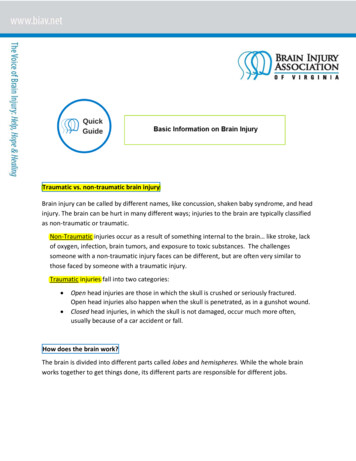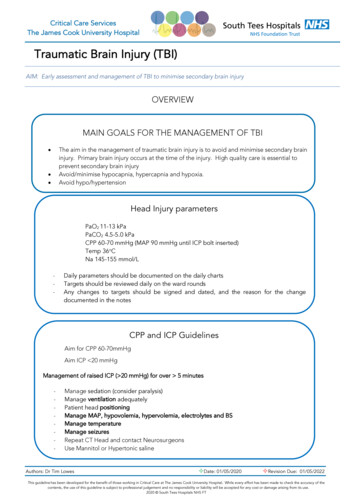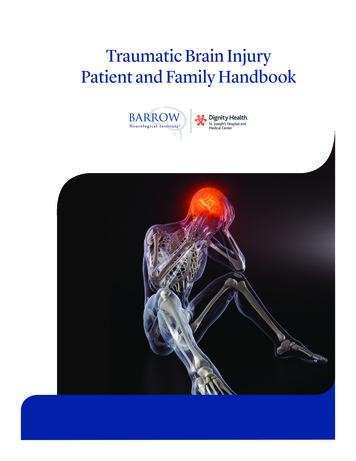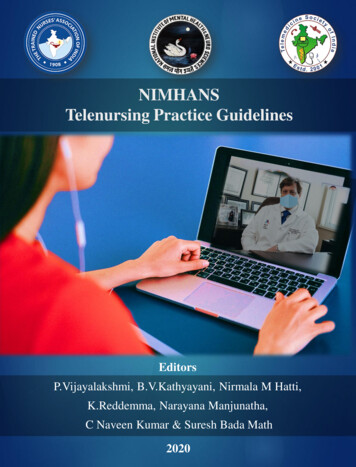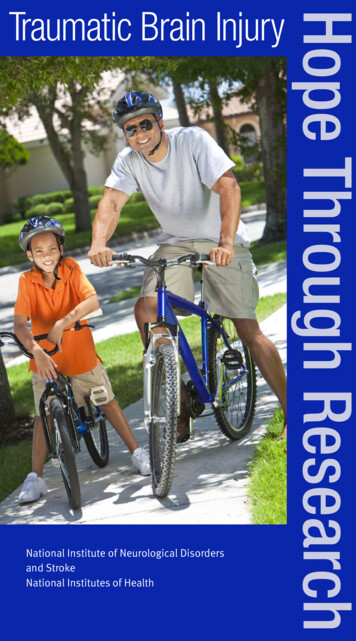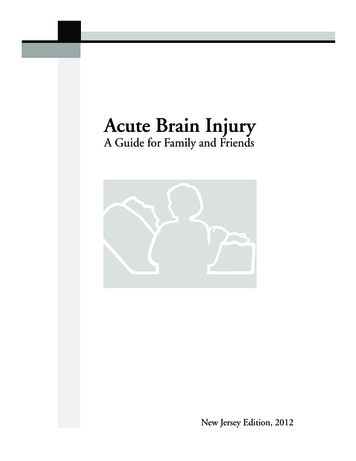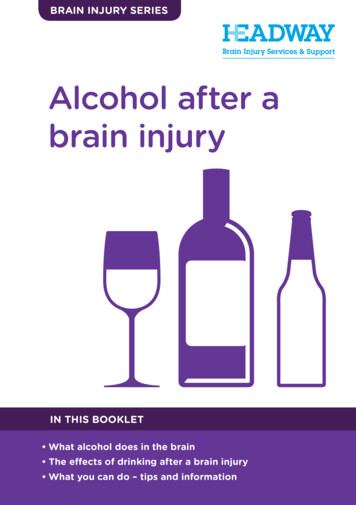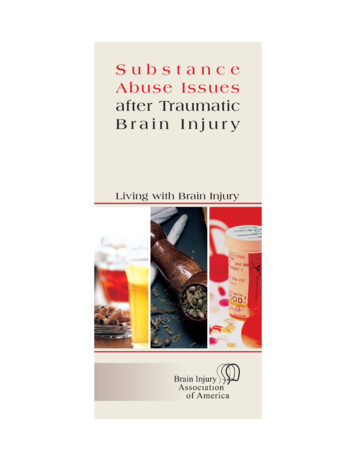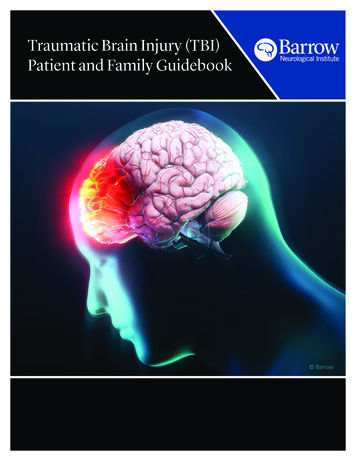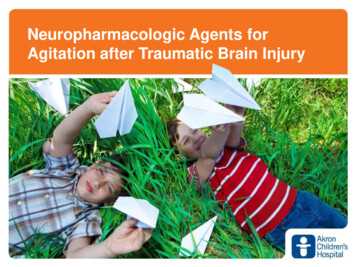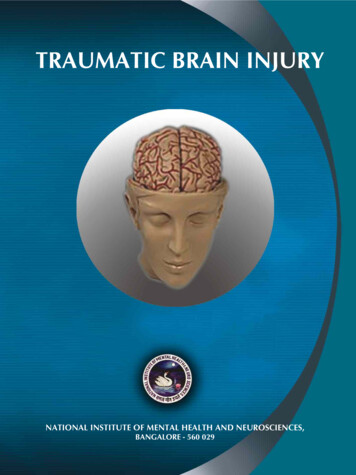
Transcription
TRAUMATIC BRAIN INJURYNATIONAL INSTITUTE OF MENTAL HEALTH AND NEUROSCIENCES,BANGALORE - 560 029
THE TEAMGururaj Ga, Kolluri S.V.R.b , Chandramouli B.Ab,Subbakrishna D.Kc & Kraus JFdResearch OfficersaTraumaticBrainInjurySuryanarayana S. P and Rajashree NarasimhanAnanda, Balachandra, H.C.S.C.R ReddyData ManageraVijendra S. KargudriDepartments of Epidemiologya, Neurosurgeryb &BiostatisticscNATIONAL INSTITUTE OF MENTAL HEALTH &NEUROSCIENCES BANGALORE, IndiaandSouthern California Injury Prevention ResearchCentred,UCLA School of Public Health, Los Angeles, USAdAddress for CorrespondenceG. GururajProfessor & HeadDepartment of EpidemiologyWHO Collaborating Centre for Injury Prevention andSafety PromotionNational Institute of Mental Health & Neuro SciencesBangalore-560029, India. e-mail: guru@nimhans.kar.nic.inSuggested CitationGururaj G, Kolluri S.V.R, Chandramouli B.A,Subbakrishna D.K and Kraus JF, "Traumatic Brain Injury",National Institute of Mental Health & Neuro Sciences,Publication no. 61, Bangalore - 560029, India. 2005
CONTENTSPage Nos.Executive Summary1. Introduction12. Neurotrauma registry: Role and purpose33. The City of Bangalore54. The study centre: NIMHANS64.1Objectives of Neurotrauma Registry5. Methodology775.1Phase - I Study75.2Phase - II Study95.3Phase - III Study106. Results116.1Socio-demographic characteristics126.2Alcohol and TBIs136.3Causes of TBIs146.4.Road traffic injuries and TBIs146.5.Falls and acquired brain injuries216.6.Violence and Neurotrauma256.7.Prehospital and emergency care276.8.Severity and nature of brain injuries306.9.Management details306.10. Economic aspects of TBIs336.11. Disabilities and Quality of Life (Phase - II study)336.12. Disabilities and Quality of Life (Phase - III Study)377. Implications and emerging Issues398. Epilogue419. Recommendations4210. Inputs from project into policies and programmes4811. Presentation in National and International meetings4812. References4913. Annexure1.Questionnaire 12.Questionnaire 2
FOREWORDTraumatic Brain Injuries (TBIs) are a major public health problem in India, resulting in deaths,injuries and disabilities of young and productive people of our society. The economic losses toIndia are phenomenal, though unmeasured. As India progresses to greater growth and development interms of motorization, urbanization, TBIs will increase in India. The recent World Report on RoadTraffic Injury Prevention and The World Report on Violence and Health by World Health Organizationclearly highlight the growing enormity of the problem of injuries across the world and the urgent needfor well designed and evaluated programmes in prevention, management and rehabilitation. Countrieslike India have not placed much greater emphasis on prevention.Any growth, development and progress in every society has to be balanced with appropriate safetypolicies and programmes in all areas. The failure to implement several proven countermeasures andneglect of people’s safety has only resulted in increase of TBIs. Technological advancements in recentyears have clearly reduced the case fatality rates from Injuries and TBIs, especially in Urban India.However, the problem continues to be high in rural and peripheral areas due to lack of adequatetrauma care. Rehabilitation services are still to reach the vast parts of the country due to lack offacilities and skilled human resources. Thus, many injured continue to live with disabilities resultingin increasing socioeconomic burden and poor quality of life. Importance should be given to all threeaspects of brain injuries, namely: prevention, management and rehabilitation, integrated through wellcoordinated activities in a systematic approach. As India has resource limitations in all areas, moremarkedly in health care, policy makers and professionals need to identify cost effective means ofdeveloping integrated programmes.The need for good quality scientific information for policy and programme development needs nooveremphasis. The lack of research and good quality data in India is often a major barrier, as we tendto undermine the importance of the problem, even though it is a major public health issue. In order tobridge this gap, the Departments of Epidemiology, Neurosurgery and Biostatistics in collaborationwith The Southern California Injury Prevention Research Center undertook this project over a period ofthree and a half years in Bangalore. This first extensive and in-depth study has documented severalepidemiological dimensions of TBIs in India, revealing the enormity of the problem. This understandingshould lead to more research and influence policies across India from several other centers. The effortsof the research team will be amply rewarded if more focus is laid on strengthening research to placeinjuries and TBIs on the public health agenda of our governments. I hope that the coming years willwitness a decline in TBIs in the Indian region.Dr. D. NagarajaDirector/Vice-ChancellorNational Institute of Mental Health and Neuro SciencesBangalore-560 029, India.March 05, 2005
PREFACEComprehensive research in India in the area of Traumatic Brain Injuries (TBIs) is extremely limited.Scientific information in this area is vital and a basic prerequisite to understand the enormity ofthe problem and its various determinants and various dimensions to formulate, implement and evaluateprograms for reduction of morbidity, mortality, disability and socioeconomic losses in every country.Earlier research in India has been extremely limited and has been from isolated settings based onpersonal areas of interest by individual researchers.Injuries are a major public health problem today. Injuries and TBIs in India have been increasingsignificantly due to rapid motorization, industrialization, migration and changing value systems ofIndian society. The consequences on health are tremendous and have been underestimated due toabsence of research. Apart from instantaneous deaths, the suffering and poor quality of life amongsurvivors is a living testimony to the impact of TBIs.Earlier research at NIMHANS has focused on examining epidemiological burden, disabilities andcausation in a limited manner through small-scale independent studies. The need for a well-designedcomprehensive study was felt by the team and also expressed by professionals on several platforms.The present study was thus conceived and carried out to examine in depth all aspects of TBIs registeredat NIMHANS. The study has adopted well-defined scientific methodologies for measurement andquantification in several areas. This report summarizes the salient findings from this study to trackevents and changes from the time of injury occurrence till 2 years after hospital discharge. The contentsfocus on the characteristics of the injured persons, where did it occur? How did it occur?, Why did itoccur ?, nature of prehospital and emergency care, course during hospital stay and nature – impact afterdischarge. As hospital based follow-ups were not adequate in terms of coverage, domiciliary interviewswere conducted for in-depth interviews of patients and family members. Broadly, the findings of thestudy cover important issues related to prevention, management and rehabilitation along with identifyingnew areas for research. The various recommendations placed at the end of the report needs immediateattention of political leaders, policy makers and professionals.This publication is also intended to stimulate and encourage research in the area of TBIs in India andother developing countries. “Accidents are no more accidents”; Unraveling the factors - causes, situations,circumstances, is crucial to initiate action in a scientific way. This understanding is also crucial tomove from present pessimistic attitudes to more optimistic thinking in the area of prevention andrehabilitation. We hope that our efforts will be amply rewarded if readers consider promoting andconducting research in this area along with placing injuries and TBIs on the public health agenda oftheir respective communities.Study teamNIMHANSMarch 05, 2005
ACKNOWLEDGMENTSTHANKSTONATIONAL INSTITUTE OF MENTAL HEALTH & NEURO SCIENCES,BANGALORE, INDIAandSOUTHERN CALIFORNIA INJURY PREVENTION RESEARCH CENTRE,UNIVERSITY OF CALIFORNIA, LOS ANGELES, USAFORFINANCIAL SUPPORT TOWARDS THIS PROJECTWe sincerely acknowledge the support and encouragement from Dr. D. Nagaraja, Director/Vice-Chancellor, NIMHANS and Dr. M. Gourie-Devi (former Director/Vice-Chancellor,NIMHANS) in conducting this study. We are highly thankful to Prof. Jess F. Kraus, Director, SouthernCalifornia Injury Research Centre and Professor of Epidemiology, UCLA School of Public Health, LosAngeles, USA, for facilitating this study by providing guidance and financial support for conductingthis study. Our sincere thanks to all the faculty members and residents of the Neurosurgery Department,Casualty Medical Officers and nursing staff of NIMHANS for extending all cooperation towards thisstudy. We are deeply indebted to Mr. Joseph and Ms.Maria and their team from the medical recordsdepartment of NIMHANS for helping with records on a day to day basis. We also are thankful toDr. Suryanarayana SP, Dr. Rajashree Narasimhan, Mr. Ananda, Mr. H.C.S.C.R Reddy andMr. Balachandra, Research Officers in the project for diligent and meticulous data collection and dataentry in the entire project. Our thanks go to Mr. Vijendra S. Kargudri for efficient data management inthe study. Thanks to Ms. Beereshwari for contribution towards manuscript development. Thanks arealso to Mr. Ravindranath for language editing of the final report. Finally, we are extremely grateful toall patients and their family members for cooperation in this study, amidst their pain and suffering.
EXECUTIVE SUMMARYIndia is facing the triple burden of communicable diseases, non-communicable diseases and injuries.The number of deaths, hospitalization, disabilities due to injuries has been increasing due to sociodemographic and epidemiological transition. The unprecedented motorization, urbanization, rapidindustrialization, increasing media penetration across society, changing lifestyles and values of peoplealong with absence of safety policies and programmes has added further to this Scenario. It is estimatedthat nearly 4,50,000 people died due to injuries during 2001 as per official report. As per a recentreport entitled “First India Injury Report: Problem – Solutions”, it is estimated that during 2004 nearly8,50,000 persons died and 16.5 million were hospitalized due to injuries in India. Among variousinjuries, traumatic brain injuries (TBIs) are a leading cause of morbidity, mortality, disability, socioeconomic losses and poor quality of life among survivors. It is estimated that nearly 1 million personsare injured, 200,000 people die and nearly 1 million require rehabilitation services every year in India.In the city of Bangalore alone, nearly 10,000 individuals sustain brain injury and more than 1,000 dieevery year. The related epidemiological information required for developing programmes in prevention,management and rehabilitation are not available in India due to lack of systematic research efforts.The present study undertaken at NIMHANS (National Institute of Mental Health & Neuro Science)during 2000-03 aimed at bridging this gap by comprehensively examining all major aspects ofNeurotrauma. NIMHANS provides care for nearly 60 - 70% of brain-injured persons in Bangalore city.7,164 persons were enrolled into a Neurotrauma Registry during the year 2000 at NIMHANS. Trainedresearch officers undertook data collection from emergency service department of NIMHANS round theclock using standard and validated instruments. Reliable methodological measures were used formeasuring socioeconomic variables, injury causes (International Classification of Diseases -10th Revisionand International Classification of External Causes of Injuries), severity (Glasgow Coma Scale), outcome(Glasgow Outcome Scale), disabilities (Modified Barthel’s Index and Glasgow Outcome Scale - ExtendedVersion) and Quality of Life (WHO Quality Of Life – BREF Version). While Phase–1 study focused onidentifying and measuring all epidemiological correlates in a hospital setting, phases–II and III focusedon identifying disability patterns, extent of socio-economic burden and measuring quality of life. Thus,all major issues with regard to preventive, managerial, rehabilitative and economic aspects have beenaddressed in this study from Bangalore. The scenario is likely to be similar for other Indian cities andin some of the other developing countries.The present descriptive summary report provides salient data from the study and future reports willdiscuss individual aspects in detail. On an average, 20 - 25 patients are registered every day with a headinjury at NIMHANS and TBIs constituted 39% of total registration during 2000. Individuals in the age group of 21 - 35 years were represented to the extent of 40% with children( 15 years) and elderly accounting for 20% and 5%, respectively with a male to female ratio of4:1.
The majority of those injured were with less than collegiate levels of education, employed inskilled and unskilled jobs, married and with income levels of Rs. 3,000 per month. Road Traffic Injuries (RTIs) (59%), Falls (25%) and Violence (10%) were the major causes ofneurotrauma. RTIs occurred predominantly in the age group of 15 - 40 years, among men and during eveningsand nights (66%). Pedestrians (26%), two-wheeler riders (31%) and pillions (12%) and bicyclists(8%) were represented in higher numbers. The majority of the RTIs took place in midblocks ofroads (70%). Not wearing helmets, driving under influence of alcohol, over speeding and overtaking,crossing in the middle of the road were the major behavioural factors. Poor visibility of vehiclesand or roads and mechanical problems of vehicles were responsible for one-third of injuries, roaddesign and structural issues were responsible for another 30% of TBIs. Falls were the second-leading cause (25%), with the majority occurring in children and elderly.Amongst them domestic falls (57%) were the leading cause followed by falls in public places(15%). Accidental falls at home (26%), falls from stairs/steps (22%) and fall from building(14%) were the common pattern of fall injuries. Violence/assault (10%) were the third-leading cause, more frequent among men and associatedwith use of blunt physical objects. Prehospital and emergency care was poor in the areas of - availability of First Aid Services (eventhough many had contacted a health care provider, recognition and management of brain injurieswas poor), high referrals from local hospitals (even for injuries which could have been managedat peripheral levels), safer transportation (ambulances were used only in 25%) and longer intervalbetween injury and reaching definitive hospital (only 13% within one hour and 40% in one tothree hours). In total, 71% of TBIs were mild, 15% moderate and 13% severe in nature based on GlasgowComa Scale. Concussions (36%), contusion (32%), skull fractures (12%) and brain haemorrhages(13%) were the injury patterns. Severe polytrauma was noticed in 22% of total injuries. Measurement of outcome based on GOS at hospital discharge time revealed that 5.5% died inhospital and 4% were discharged in a persistent vegetative state. Severe and moderate disabilitieswere observed in 15% and 37%, respectively. Various types of disabilities affecting activities of daily living, memory, communication, socialinteraction and ability to work were seen in 52% of the patients at hospital discharge time. Phase II and III study of the present project (community based follow-up study) focused onmeasuring disability patterns, socioeconomic burden and quality of life at 1 and 2 years afterdischarge. Nearly 35% had problems in health, social, economic dimensions of life at 1-yearfollow-up, while more than 50% of them continued to have problems in similar areas at second
year follow up also. The study has brought out a clear need for well planned and cost effectiverehabilitation services in the city. The sudden occurrence of TBIs had placed a major economic burden on individuals and familiesto meet costs of hospitalization and rehabilitation. The affected families had to spend resources(their own or borrowed from external source) to reach definitive hospitals, to take care of injuredperson during hospital stay and after discharge. This however excludes expenditure met by thehospital to provide care as these costs are subsidized in public hospitals. The indirect costs due toloss of work and income are substantial and are not routinely included in costing exercises. Thus,the total costs are huge and phenomenal for developing societies. The quality of life was poor in nearly 30% of brain-injured persons at two years post discharge.The study after comprehensively examining all major aspects of neurotrauma has placed severalrecommendations for prevention, management and rehabilitation of brain injuries. Theserecommendations are based on findings from study, perspectives of professionals and reactions ofsurvivors and families. Information from project has been freely shared with policymakers, professionalsand public (through press) for bringing in well-organized service and prevention programmes. TheGovernment of Karnataka should urgently consider implementing the following major interventionsthrough its member departments with the broader aim of reducing the burden of TBIs. These include:i)Implementing helmet legislation by immediate notification and strict enforcement;ii)Reducing drinking and driving by strict enforcement;iii)Speed control mechanisms within and outside city by engineering and enforcement measures;iv)Improving pedestrian facilities by engineering solutions;v)Increasing visibility of vehicles and roads;vi)Better organization of emergency and prehospital care facilities;vii)Introducing trauma audits in hospitals;viii) Strengthening training of doctors and allied personnel in early recognition and management ofbrain injured persons;ix)Improving facilities in taluks and district hospitals (making them as integrated trauma care centres);andx)Organization and delivery of rehabilitation services.Description of these recommendations along with important details can be found at the end of thereport. Needless to say, increasing awareness across society for various measures should be inbuilt intorespective programmes. A greater level of awareness on safety on roads, homes, workplace is very muchrequired at all levels with development and implementation of safety policies and programmes. Thisrequires integration and better coordination along with implementation and evaluation of programmesat all levels. Undoubtedly, this man-made tragedy can be effectively controlled and needs a vision andmission to act.
1IntroductionThe demographic, epidemiological and economic transition in India has changed thehealth scenario in a significant way during the last two decades. This shift in health problemsand priorities has brought the entire spectrum of non-communicable diseases and injuries tothe forefront of health care delivery system. Among these emerging problems, man-madeand behavior-linked injuries occupy a significant place. The rapid urbanization,industrialization, motorization and changing lifestyles of individuals have given rise to aplethora of problems, among which injuries top the list. A number of social factorsaccompanying this change like increasing migration, large-scale housing and constructionactivities, economic reforms, increasing import of technology without safety criteria, lack ofsafety measures on road at home and in work and play sites, emerging problem of alcoholand drugs, increasing violence and crime rates and the general absence and disregard tosafety practices at all places has contributed to an alarming increase of injuries. The gradualdecline of communicable diseases and advances in health care technology has also been oneof the factors for the emergence of injuries as a major public health problem. A steep increasein vehicle and human population traversing the adverse road situations has made road trafficinjuries a serious condition. Meagre prehospital care with added delay in emergency carehas only added further to rising mortality and disability rates. The phenomenal increase inmorbidity, mortality, disability and socio-economic impact from injuries, and brain injuriesin particular, during the past decade has been a matter of increasing concern amongprofessionals and policy makers.At the global level, it is estimated that the annual incidence and mortality from AcquiredBrain Injury (ABIs) or Traumatic Brain Injuries (TBIs) is 200 and 20 per 1,00,000 per year,respectively (1). National level data in India is not available for traumatic brain injuries as inmany developed countries. The only epidemiological study undertaken in Bangalore by theauthors has revealed that the incidence, mortality and case fatality rates were 150/1,00,000,20/1,00,000 and 10%, respectively(2, 3). At the national level, nearly two million people sustainbrain injuries, 0.2 million loose their lives and nearly a million need rehabilitation servicesevery year. Nearly 10,000 people sustain brain injury every year in the city of Bangalore withmore than 1,000 deaths. The data also showed that the majority of these individuals aremales, in their early years (5 - 44 years) and often involved in road traffic injuries. The survivorsof injuries had various problems in day-to-day life affecting almost every sphere of life. Thestudy also highlighted the lack of comprehensive, integrated, preventive and rehabilitativeprogrammes in the city of Bangalore as noticed in the rest of the country.1
Epidemiological indicators of TBI in India & Bangalore (estimates for 2001).IndicatorsRatesPopulation withTBI in IndiaPopulation withTBI in KarnatakaPopulation withTBI in nce97/100,000/yr1,000,00051,0005,000Case fatality rate9%---Among all types of injury, neurotrauma — injury to the central nervous system has seriousconsequences and major implications. Literature from the West and limited data from Indiaindicate that these injuries cause enormous suffering and losses not just to individuals, butalso families and communities (4). The resulting damage from an injury to an individual wouldrange from a state of sudden shock to instantaneous death. A survivor will have brain injuriesvarying from superficial injuries to a permanent vegetative state. Apart from physical damageand neurological disabilities of different types, psychosocial problems like fear, anxiety andsuffering will affect the individual even after discharge from the hospital. The recovery frominjury will take years depending on physiological factors and pathological damage. Theaffected individual will go through pain and suffering of immense nature for long periods oftime. Hospitalization may be needed for brief or long periods. During this period he/she willlose work and has to pay for medical expenses, often determined by type of injury and levelof care along with accessibility to services.Apart from loss of precious human resources in their productive age groups, traumaticbrain injuries place significant burden on our societies. Damage to property and vehicles,loss of productive man-years, work absenteeism and compensation claims are only a fewmanifestations of injury. Indirectly, decreased productivity, cost of repair and maintenanceof vehicles and goods, and long-term impact of scholastic and occupational loss arephenomenal and unmeasured. The burden on health care services is considerable as publicfunds are allocated towards acute, intermediate and long-term care. With increasingtechnological orientation for diagnosis and management along with privatization of healthcare, the economic impact on individual, family and society has increased and is bound toincrease. Information on economic burden of injuries is not available for the country as awhole or for any selected cities. It is estimated that the total costs of road traffic injuries aloneis about 3% of GDP in India (5).The World Health Organization and several other leading agencies have recognized thecritical need for effective ways to prevent the occurrence of these injuries, to provide2
appropriate care for those injured and for rehabilitation of survivors. In order to effectivelyorganize and implement these programmes in an acceptable, cost-effective and sustainablemanner reliable information is required in every country. This is crucial to influencepolicymakers and public health administrators. These programmes require good informationbased on well-designed and scientific epidemiological studies. Information is required onthe number of persons affected, persons at increased risk of injury, nature of external causes,severity of injuries, outcome and impact of traumatic brain injuries for designing andimplementing interventions.Epidemiology, defined as “the study of distribution and determinants of health and relatedevents in population” and the application of this information for improving health ofcommunities. A major purpose of epidemiologic studies and surveillance is to provideinformation necessary for primary prevention (avoiding the occurrence of injury), secondaryprevention (early diagnosis and treatment) and tertiary prevention (mitigating the sequelae ofinjury and reducing consequent disability). To assess the public health importance of injuriesand to design and implement effective injury prevention programmes, it is necessary to describethe (1) magnitude of the problem (e.g., total number of persons with neurotrauma in terms ofincidence and mortality rates and prevalence of resulting impairments), (2) population athighest risk of injury (varied subgroups in population), (3) causes (external causes andcircumstances of injury) and, (4) severity and outcome (e.g., type of injury, case fatality ratio,patient disposition, resulting disability, cost of care and impact of injuries). Any interventionsdeveloped and implemented in society needs to be evaluated in a scientific way. Thus,descriptive, analytical or interventional studies help in defining the problem and bringing theissue on the public health agenda of individual societies and communities. However, carefulattention has to be paid for case definition, case identification methods, inclusion and exclusioncriteria, and classification methods in any type of study. Epidemiology also has to movebeyond ‘counting heads’ to organizing affordable, cost-effective and sustainable injuryprevention policies and programmes in developing countries.Neurotrauma epidemiological research is the scientific study of distribution (problem) oftraumatic brain injuries in a given population, their causes and risk factors with the purposeof identifying mechanisms and approaches to prevent (reduce) the occurrence of injuries,reduce severity and to organize need-based rehabilitation services. Establishing neurotraumaregistries in different areas helps in comparing the various dimensions of the problem,developing interventional strategies and to learn success and failures for future remedialmeasures.3
2Neurotrauma registry: Role and purposeThe use of disease-specific registries in epidemiological research needs no special emphasis.Several registries established in different areas have shown that population based and hospitalbased registries are widely accepted and have been of tremendous scope for descriptive,analytical and interventional research, thus contributing for the development of services. Thehospital-based and population-based Cancer Registries in India are classic examples ofregistries and their contribution to cancer prevention and control are well known. To register,means: 'to set down formally in writing, to enter or record in a precise manner'. Brooke in1974 described a registry as availability of uniform information, about individual persons,collected in a systematic manner to serve a predetermined purpose (6). Several uses of aregistry are: (1) Identification of individuals; (2) Immediate protection of an individual; (3)Surveillance purposes, (4) Treatment evaluation and (5) Service evaluation (7).A Neurotrauma Registry provides detailed description on various components ofneurotrauma. Two major issues to be kept in mind are systematic data collection activitiesbased on uniform set of data from all registered cases, and keeping the registry sensitive (notto miss out subjects with TBI) and specific (to exclude non TBI subjects). This would ensureenrolling all TBI subjects in a given hospital. Thus, a neurotrauma register provides detaileddescription of all individuals sustaining a TBI during a given period (beginning with a date) ina defined population, the major demographic features of which are known and representativeof the selected population.The criteria of a neurotrauma registry are:1) Uniform definition2) Inclusion of all subjects with a TBI in a defined area3) Case identification from multiple sources4) Case evaluation by a trained team5) Consistency in diagnosis6) Established classification methods.Employing these criteria will help in strengthening data-collection procedures and bringuniformity across centres or even within one centre. These issues will be elaborated furtherin subsequent sections of this report. This essentially amounts to adopting objective diagnosticcriteria, objective diagnostic evaluation, uniformity in information gathering by all personsinvolved and data pooling on a prospective basis. It is essential to note that case definition;4
methods of case ascertainment and procedures of classification remain uniform throughoutthe operation of
Subbakrishna D.K and Kraus JF, "Traumatic Brain Injury", National Institute of Mental Health & Neuro Sciences, Publication no. 61, Bangalore - 560029, India. 2005 Traumatic Brain Injury. Page Nos. . However, the problem continues to be high in rural and peripheral areas due to lack of adequate trauma care. Rehabilitation services are still to .
